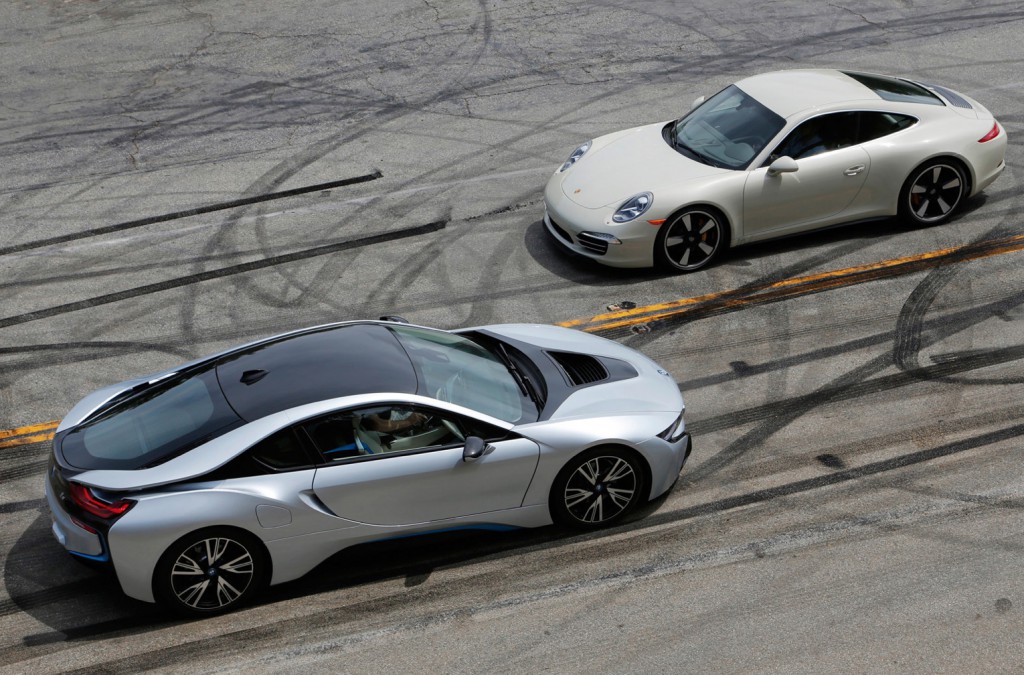BMW i8 vs Porsche 911: Hybrid or a Proven Performer?

The Porsche 911 for sale is the benchmark performance car and one which every company compares their own against. Sophisticated enough for well-heeled clients but affordable enough for more modest enthusiasts, it occupies a fairly broad spectrum in the automotive world and has established itself as not only a beautiful, luxurious car but a consummate performer. Constantly refined and improved upon since its inception, the 911 is as quick and robust as it is comfortable. Drive a 911 hard and, like a proud masochist, it begs for more.
Once a fairly spartan, uncompromised sports car, the 911 in modern guise is comfortable and very usable, though it remains true to the ethos of the original car. So what happens when another German powerhouse known for its performance cars takes the game one step further? Is it fair to compare the established touchstone to something with a fundamentally different approach? Most importantly, if the two are comparable, will this change the future of performance automobiles?
To many forward-thinkers, the answer is yes. BMW’s new i8 has strutted its way into the world arena with its Batmobile-styling and a complicated, hybrid powertrain. Deftly balancing environmental concerns with a need to keep up its reputation, BMW has devised this futuristic fighter not only to get stellar mileage but remain a competent performer with realistic pricing. This combination makes it a trend-setter in many ways, since hybrid drivetrains have until now powered economy cars or million-dollar hypercars. Additionally, it’s sumptuous, starship interior and real-world usability put this is clear contention with the accomplished 911. While not cheap, the BMW i8 for sale could pave the way for attainable hybrid sports cars in the future.

Pushing the 3,400 pound car around is a three-cylinder turbo engine coupled to an electric motor which powers the front wheels. In total, the car produces 357 horsepower and 420 lb/ft of torque. Turn on launch control, and the i8 will sprint in an effortless, muted whoosh to 60 mph in 3.6 seconds thanks to four wheel-drive traction and instantaneous, electric torque. Unfortunately, the car is limited to 155 mph but outside of the Autobahn and some racetracks, it will be tough to get going that quickly anyways. The combustion engine and electric motor work harmoniously; producing a smooth, seamless surge of power that may lack drama but is predictably efficient. To compensate for the dulled engine note, BMW has supplements the actual engine note with a fabricated soundtrack played through speaker system. Divisive? Yes, but the combustion engine’s bark – reminiscent of the NSX’s – and the hybrid whine give it an interesting sound nonetheless.
Inspect the front axle of this car and it seems as if somebody’s fitted tires from a model T to the wheels. In an effort to reduce rolling resistance, BMW has opted to run narrow 215 and 245-section tires at the front and rear, respectively. This limits the car’s ability to turn in at speed and requires a bit of patience in slower corners. Crucially, this prevents the car from having a confidence-inspiring, incisive feel on turn-in, but makes up for this shortcoming with great balance and adjustability.
Perhaps what has surprised reviewers most about this techno-fest is the way the car will pivot into the corner with a release of the throttle or a rub of the brake. Thanks to its mid-engine layout, the chassis offers a nimbleness that is handicapped by the tires. This willingness to rotate mid-corner makes up for its lack of front end-grip and hints at BMW’s urge to keep its modern cars entertaining. While remaining poised and well-behaved, it has some of that tail-happy characteristic that makes BMW’s sports cars so fun to drive.

Photo Credit: Fabian Kirchbauer & Alberto Martinez
If driving pleasure is part of makes the 911 a desirable car, it has to be quick but also involve the driver. The most recent generation of 911, the 991, has come under heavy criticism because of its electric steering system which, despite not delivering the same degree of feel its predecessors did, offers enough conversation between the steering wheel and tires so that, on track, there is no delay, no vagueness and no uncertainty. Turn the steering wheel and the chassis speaks to you in Dolby Surround Sound.
Coupled to the immense traction and poise this car offers is a scintillating 424 horsepower and 325 lb/ft of torque in the comparatively-priced 911 GTS. While the car lacks a turbocharger and an electric motor, it more than makes up for those with brilliant throttle response and a sonorous engine note from the 3.8-liter flat-six. Without question, the ambiance offered by the Stuttgart engine makes for a much more visceral driving experience. Its sprint to sixty takes slightly longer – 4 seconds – but continues to a respectable 188 mph top speed.
All in all, the Porsche is louder, more incisive and more responsive. On track, it will walk all over the i8, but nobody expected otherwise. What the i8 does do is surprise everyone with the promise it makes for the future of sports cars. Considering its complicated drivetrain, weight and compromises made for economy, it’s a surprisingly fun car to drive and a harbinger of entertaining hybrid cars down the road. Perhaps the future of sports cars won’t be bleak and Orwellian but full of pleasure coupled with technical ingenuity. With the acceleration figures hybrid drivetrains can offer and the proven chassis balance seen in the i8, it would be foolish to assume that the petrolhead’s time in the sun has come to an end. What could an i8 do if the M Division got their hands on it? Only time and rising fuel prices will tell, but it’s safe to say that there’s a future for both fuel efficiency and fun.
